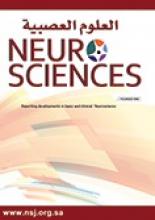To the Editor
With reference to the interesting case report by Bakhaidar et al,1 I presume that the evolution of the intracerebral aneurysm could not be solely attributed to the congenitally acquired human immunodeficiency virus (HIV) infection. The authors mentioned that their studied 7-year-old boy was tested positive for HIV infection 2 years earlier when he was presented with severe dyspnea and cough due to pulmonary tuberculosis (TB). He had a remarkable recovery at that time and was discharged on an 18-month course of anti-TB therapy and antiretroviral therapy. He was presented to the emergency department 18 months after with a new onset of generalized tonic-clonic convulsion, and it was proved by imaging studies to have intracerebral fusiform aneurysm.1
It is obvious that TB remains to be an endemic infectious disease in the developing countries. With the increasing incidence of HIV infection and AIDS, there is a further increase in the incidence of TB. Central nervous system TB (CNSTB) might present as tuberculoma, cerebral abscess, or tuberculous meningitis (TBM). Vasculitis secondary to TBM could cause infarcts and aneurysm formation.2 Hence, I presume that the case in question represents a concomitant HIV infection and TB- associated aneurysmal arteriopathy. My assumption is further supported by the following 3 points. 1.
Though the estimated incidence of all forms of TB fell from 15.8/100000 (95% CI: 15.3/100,000-16.3/100,000) in 2010 to 13.8/100,000 (95% CI: 13.4/100,000-14.2/100,000) in 2011 and the proportion of extrapulmonary TB, including CNSTB increased minimally from 30% in 2010 to 32% in 2011, TB still represents an important health threat in Kingdome of Saudi Arabia (KSA).3 2. Though no recent studies are yet present on the magnitude of HIV and TB co-infection in KSA, the available data pointed out to a rate of 1.1-7.4%.4,5 3. In KSA, TB still contributes to deaths. Among many factors, HIV seropositivity has been noticed to positively correlate with mortality.6 I presume that Bakhaidar et al1 did not consider HIV and TB co-infection in their studied patient by an appropriate TB diagnostic algorithm, particularly histopathologic examination of tissues obtained during successful surgical reconstruction of the intracerebral aneurysm. If that diagnostic algorithm was employed and it was proved to be a case of TB, the case in question would be a novel case report as pediatric concomitant HIV infection and TB- associated aneurysmal vasculopathy have not been reported in the literature.
Reply from the Author
We read with interest the correspondence by Dr. Al-Mendalawi regarding our recent publication “De Novo intracerebral aneurysm in a child with acquired immunodeficiency syndrome”.1 We presented a documented evolution and natural history of the intracerebral aneurysm in 7-year-old boy, who was an outcome of pregnancy of a known HIV infection mother. He raised a legitimate question whether there was any evidence of central nervous system TB in our patient besides HIV infection, which may have contributed, in intracranial arteriopathy and development of the aneurysm.
As clearly stated in the case report, our patient had pulmonary TB, which was adequately treated with 18-month course of anti-TB therapy. We are aware with the literature evidence of TB vasculitis and its consequences, particularly in HIV infection patients. We have performed cerebrospinal fluid analysis early and later in the course of his disease particularly testing for evidence of TB and there was no evidence. Furthermore, the documented MRI of the brain was performed several times without radiological evidence of intracranial (parenchymal or leptomeningeal) TB.
We disagree with Dr. Al-Mendalawi’s assumptions that there was any evidence of intracranial TB based on the above evidence which was clearly stated in the case report;1 we were aware of such association and because of lack of evidence, it was not mentioned in the discussion. Therefore, we are assertive that the diagnosis of the intracranial aneurysm in our patient was due to his HIV infection conclusion. We thank Dr. Al-Mendalawi for his interest in our research and for raising the awareness of possible association of TB in HIV infected patients.
Saleh S. Baeesa Division of Neurosurgery, Faculty of Medicine King Abdulaziz University Jeddah, Kingdom of Saudi Arabia
- Copyright: © Neurosciences
Neurosciences is an Open Access journal and articles published are distributed under the terms of the Creative Commons Attribution-NonCommercial License (CC BY-NC). Readers may copy, distribute, and display the work for non-commercial purposes with the proper citation of the original work.






